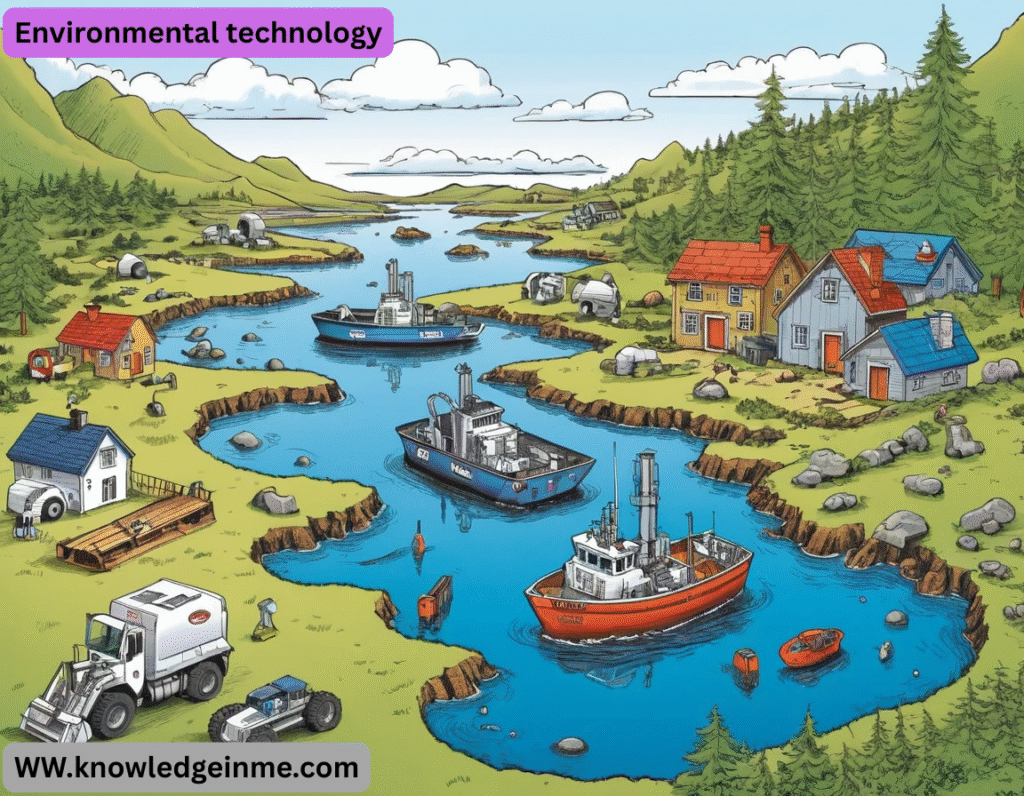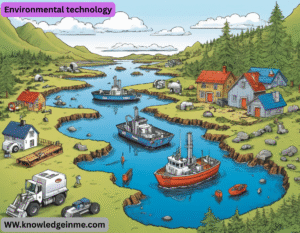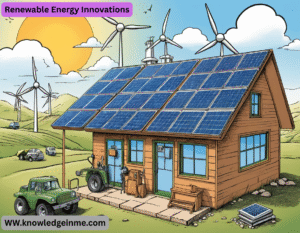Environmental technology Environmental Technology refers to the application of engineering, chemistry, biology, and other sciences to monitor, mitigate, and prevent environmental damage while promoting sustainability. It includes innovations designed to reduce pollution, conserve resources, and combat climate change.
Key Areas of Environmental Technology
Renewable Energy
- Solar, wind, hydro, and geothermal power technologies.
- Energy storage solutions (e.g., advanced batteries).
Waste Management & Recycling
- Smart waste sorting & recycling systems.
- Waste-to-energy (incineration, biogas).
- Biodegradable and compostable materials.
Water & Air Pollution Control
- Advanced filtration (e.g., reverse osmosis, nanofiltration).
- Carbon capture and storage (CCS).
- Air purifiers & emissions control (e.g., catalytic converters).
Sustainable Agriculture
- Precision farming (IoT sensors, drones).
- Hydroponics & vertical farming.
- Biofertilizers & organic pest control.
Green Building & Smart Cities
- Energy-efficient architecture (e.g., passive houses).
- Smart grids & energy management systems.
- Urban green spaces & eco-friendly infrastructure.
Environmental Monitoring & AI
- Remote sensing (satellites, drones).
- AI-powered pollution tracking.
- IoT-based environmental sensors.
Benefits of Environmental Technology
- Reduces carbon footprint & combats climate change.
- Improves public health by reducing pollution.
- Enhances resource efficiency (water, energy, materials).
Challenges:
- High initial costs for deployment.
- Need for global policy support.
- Technological limitations in scalability.
Renewable Energy Innovations
Next-Gen Solar Panels:
- Perovskite solar cells (higher efficiency, lower cost than silicon).
- Bifacial panels (capture sunlight on both sides).
- Solar skins (aesthetic panels blending with rooftops).
Wind Energy Breakthroughs:
- Floating wind turbines (for deep-water offshore farms).
- Vertical-axis turbines (suitable for urban areas).
Energy Storage:
- Solid-state batteries (safer, higher capacity for EVs/grids).
- Gravity storage (using weights in abandoned mineshafts).
Waste-to-Resource Technologies
Plastic Waste Solutions:
- Enzymatic recycling (breaking down plastics to raw materials).
- Pyrolysis (converting plastic waste into fuel).
Circular Economy Tech:
- 3D printing with recycled materials (e.g., ocean plastics).
- Food waste biorefineries (producing biofuels, fertilizers).
E-Waste Mining:
- AI-driven sorting robots to recover rare metals (gold, lithium).
Water Tech Revolution
Desalination Advances:
- Graphene membranes (lower energy use for salt removal).
- Solar desalination (passive systems for rural areas).
Smart Water Networks:
- AI leak detection (preventing pipe losses in cities).
- Atmospheric water harvesters (extracting water from air).
Air Quality & Carbon Capture
Direct Air Capture (DAC):
- Clime works (Iceland) – Captures CO₂ and stores it underground.
Hyperlocal Pollution Tracking:
- Low-cost sensors (e.g., Purple Air for community monitoring).
Sustainable Agriculture & Food Tech
Lab-Grown Meat:
- Cultivated meat (e.g., UPSIDE Foods) reduces livestock emissions.
Precision Farming:
- AI drones detect crop diseases early.
- Robotic weeders cut pesticide use.
Algae & Insect Protein:
- Alternative protein sources with low environmental impact.
Green Hydrogen Economy
Green Hydrogen (H₂):
- Made via electrolysis (using renewable energy).
- Used in heavy industries (steel, shipping) to replace fossil fuels.
Challenges:
- High production costs; needs infrastructure (pipelines, storage).
Smart Cities & Green Infrastructure
Self-Healing Concrete:
- Embedded bacteria repair cracks, reducing CO₂ from cement.
Cool Roofs & Pavements:
- Reflective surfaces combat urban heat islands.
Biodiversity & Conservation Tech
AI for Wildlife Protection:
- Trail Guard AI – Stops poaching with camera alerts.
- Bioacoustics – Monitors ecosystems via sound (e.g., Rainforest Connection).
Coral Reef Restoration:
- 3D-printed reefs to regrow marine habitats.
Cutting-Edge Renewable Energy
Beyond Solar & Wind:
- Nuclear Fusion (2024–2030 Pilots):
- ITER (France) and SPARC (MIT/CFS) aim for net-energy-positive fusion by 2030.
- Helion Energy (backed by Sam Altman) uses pulsed magnetic fusion for helium-3 reactions.
Tidal & Wave Energy:
- Orbital Marine Power (Scotland) – 2MW tidal turbines powering 2,000 homes.
- Cal Wave (California) – Submerged wave-energy converters with 50-year lifespans.
Energy Storage Breakthroughs:
- Liquid Metal Batteries (AMBRI):
- Low-cost, long-duration storage for grids (20+ years, no degradation).
Hyper-Efficient Carbon Removal
Beyond Direct Air Capture (DAC):
Enhanced Weathering:
- Project Vesta – Spreads olivine sand on beaches to accelerate CO₂ absorption (1 ton of olivine removes 1.25 tons of CO₂).
Carbon-Negative Materials:
- Mycelium Insulation (Ecov ative):
- Grows building insulation from fungi (carbon-sequestering and fire-resistant).
CO₂-Concrete (CARBI Crete):
- Cures cement-free concrete with CO₂ instead of water (each block traps 1 kg of CO₂).
Zero-Waste Circular Systems
Plastic Alternatives:
PHA Bioplastics (RWDC Industries):
- Marine-degradable polymers made from microbial fermentation.
Nanocellulose (Sappi, Finland):
- Stronger than plastic, derived from wood pulp (used in packaging, textiles).
Waste Gold Mining:
Blue Oak Resources (USA):
- Extracts gold, copper, and rare earths from old circuit boards using bioleaching (bacteria).
Water Tech: From Scarcity to Abundance
Atmospheric Water Harvesting (AWH):
SOURCE Hydro panels (Arizona):
- Solar-powered panels pull 5L/day from air (used in UAE deserts).
MOF-303 (UC Berkeley):
- Metal-organic frameworks (MOFs) harvest water at 20% humidity (1 kg MOF = 200L/day).
AI for Water Systems:
WINT Water Intelligence (Israel):
Uses AI to detect leaks in real-time (saved 45% water at Microsoft’s HQ).
AGRI-Tech: The Future of Food
Precision Fermentation:
- Perfect Day – Makes dairy proteins via microbes (no cows).
- Solar Foods (Finland) – Produces protein from CO₂ and electricity (“SOLEIN” powder).
Robotic Farming:
- Iron Ox (California) – Autonomous hydroponic greenhouses (30x yield per acre).
- Terra Clear – AI-powered rock-picking robots for no-till farming.
Green Hydrogen: The Next Energy Revolution
Breakthroughs in Production:
Solid Oxide Electrolysis (SOEC):
- 30% more efficient than PEM/alkaline ELECTROLYZERS (Bloom Energy, 2024).
Photocatalytic Water Splitting:
- Uses sunlight + catalysts to produce H₂ without electricity (Tokyo Univ. prototype).
Global Projects:
- NEOM Green Hydrogen Project (Saudi Arabia):
- $8.4B plant to produce 1.2M tons/year by 2026 (powered by 4GW renewables).
Smart Cities of 2030
Self-Sustaining Infrastructure:
Singapore’s Super Trees:
- Solar-powered vertical gardens that collect rainwater and cool the city.
Energy-Positive Buildings:
- Generates 2x the energy it consumes (via solar, geothermal, and smart grids).
Conservation Tech: Saving Ecosystems
De-Extinction & Rewilding:
Colossal Biosciences – CRISPR-engineered woolly mammoths to restore Arctic grasslands.
BIOACOUSTIC Monitoring:
- ARBIMBON AI – Tracks endangered species via jungle sounds (used in Amazon, Congo).
AI-Powered Anti-Poaching:
- PAWS (Protection Assistant for Wildlife Security):
- Predicts poacher routes using game theory + satellite data (reduced poaching by 50% in tests).
The Next Decade: 2030 Predictions
- Space-Based Solar Power (UK’s CASSIOPEIA project beams energy from orbit).
- Programmable Bacteria (e.g., synthetic microbes that eat oil spills or produce biofuels).
- AI Climate Models – Predict regional impacts with 95% accuracy, guiding policy.
Key Challenges Ahead
- Critical Mineral Shortages (lithium, cobalt for batteries).
- Energy Density Limits (hydrogen storage, battery tech).
- Ethical Dilemmas (geoengineering risks, genetic conservation).
Energy: Breaking Physical Limits
Quantum Energy Harvesting
Ambient Energy Capture:
- MIT’s RFLY device harvests WIFI/5G signals to power IoT sensors (0.1W/m²).
- Pyroelectric nanogenerators (Georgia Tech) convert waste heat from engines into electricity.
Nuclear 2.0
Microreactors (2025+):
- Nu Scale’s 77MWe SMRs (first U.S. deployment in Idaho by 2029).
- Thorium Molten Salt Reactors (China’s TMSR-LF1 prototype achieves criticality in 2024).
Fusion-Fission Hybrids:
- General Fusion + Terra Power use fusion neutrons to burn nuclear waste as fuel.






